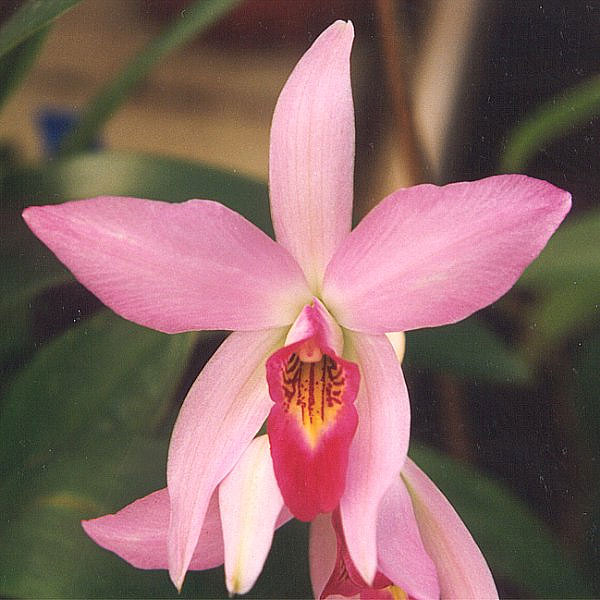- Laelia
Taxobox
name = "Laelia"

image_width = 250px
image_caption = "Laelia anceps "
regnum =Plant ae
divisio = Magnoliophyta
classis =Liliopsida
ordo =Asparagales
familia =Orchidaceae
subfamilia =Epidendroideae
tribus =Epidendreae
subtribus =Laeliinae
alliance = Cattleya
genus = "Laelia"
genus_authority = Lindl., 1831
subdivision_ranks =Species
subdivision = See text."Laelia", abbreviated L in horticultural trade, is a small genus of eleven species from the orchid family (
Orchidaceae ). This is one of the most important and popular orchid genera, because of the beautiful flowers, their genetic properties and because they are fairly easy in culture. It is probably named after Laelia, one of theVestal Virgin s. Another possibility is the name borne by female members of the Romanpatrician family of Laelius.They are found in the subtropical or temperate climate of
Central America , but mostly inMexico . "Laelia speciosa" is a high-elevation plant, preferring sunny, dry and cool conditions. The others grow in the rainforest with a warm, humid summer and a dry cool winter. The species "L. albida", "L. anceps" and "L. autumnalis" prefer higher and cooler altitudes.Most are
epiphyte s, but a few arelithophyte s, such as" Laelia anceps". They are closely related to "Cattleya" with only the number of pollinia differing. Stems are usually short, however the stem of "Laelia anceps" can be more than 1 m long. The ovatepseudobulb s are clearly separate. These are about 6 - 30 cm long. One or two waxy, leathery leaves develop from each pseudobulb. This leaf can be up to 20 cm long. The inflorescence is a raceme, which can be 30 cm long, with up to eight flowers, growing from the top of the pseudobulb. Theseflower s can be pink to purple, with a beautifully colored purple lip becoming white close to the column . They bloom in spring or autumn.Albino varieties are rare and therefore prized. Due to high demand for such a rare mutations, many horticultural labs use modern tissue culture or mericloning techniques to increase their availability.Members of this genus tend to be fairly easy in culture, and some plants are surprisingly drought-tolerant. Culture is highly dependent upon the natural habitat of the species in question, although many do well as mounted (plaqued) specimens so that the roots receive plenty of air circulation and a sharp wet-and-dry cycle.
Many species from South America, which used to belong to "Laelia", are now classified under "
Sophronitis " (van den Berg and Chase "Lindleyana" 15 (2), page 115, June 2000). The taxonomic status of some of these species is somewhat in doubt as they were moved there on the basis ofmolecular phylogeny . It seems likely that some growers and taxonomists will reject these changes, and continue to accept these "Sophronitis" species as laelias."Laelia" species readily form hybrids within the genus, and with other genera, including "
Cattleya " (x Laeliocattleya, more than 2,000 greges), "Brassavola ", "Rhyncholaelia ", and "Sophronitis ". The majority of orchid hybrids belong to this category, i.e. x Sophrolaeliocattleya, x Brassolaeliocattleya and a number of other variations.Species
*"
Laelia albida " Bateman ex Lindl., 1839 (Mexico).
*"Laelia anceps " Lindlm., 1835 (Mexico to Guatemala).
**"Laelia anceps" subsp. "anceps" (Mexico to Guatemala). Pseudobulb epiphyte
**"Laelia anceps" subsp. "dawsonii" (J.Anderson) Rolfe, 1922 (Mexico - Guerrero, Oaxaca). Pseudobulb epiphyte
*"Laelia aurea " A.Navarro, 1990 (Mexico - Durango, Sinaloa, Nayarit).
*"Laelia autumnalis " (Lex.) Lindl., 1831 (Mexico).
*"Laelia crawshayana " Rchb.f., 1883 (Mexico - Jalisco).
*"Laelia eyermaniana " Rchb.f., 1888 (N. & W. Mexico).
*"Laelia furfuracea " Lindl., 1839 (Mexico - Oaxaca).
*"Laelia gouldiana " Rchb.f., 1888 (Mexico - Hidalgo).
*"Laelia harpophylla "
*"Laelia rubescens " Lindl., 1840 (Mexico to C. America).
*"Laelia speciosa " (Kunth) Schltr., 1914 : Mayflower orchid (Mexico).
*"Laelia superbiens " Lindl., 1840 (Mexico to Nicaragua).Synonymy The genus "Amalia"
Rchb. is generally included here.
Wikimedia Foundation. 2010.
